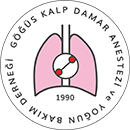

Anaesthetic Management In A Heart Transplantation Patient With Amiodarone Associated Thyrotoxicosis
Cengiz Şahutoğlu1, Zeynep Pestilci1, Seden Kocabaş1, Fatma Zekiye Aşkar1, Aslı Hepkarşı1, Çağatay Engin21Ege University Faculty Of Medicine, Anaesthesiology And Reanimation Department, Izmir, Turkey2Ege University Faculty Of Medicine, Cardiovasculer Surgery Department, Izmir, Turkey
Introduction: The elective surgery of patients with abnormal thyroid function can be delayed until they are euthyroid with medical treatment. We present the anaesthetic management of a patient with amiodarone associated thyrotoxicosis undergoing heart transplantation.
Case Report: A 20 year old female patient diagnosed as cardiomyopathy developed tamponade and cardiac arrest due to heart biopsy. The patient was resuscitated, cardiac tamponade was decompressed and amiodarone was started for ventriculer premature beats. The patients ejection fraction was 30% on echocardiography done two years later and thyroid function tests were FT3: 11,8 pg mL-1, FT4>12 ng dL-1 ve TSH: 0,001 µIU mL-1. The patient was started on propylthiouracil and metilprednisolone therapy with the diagnosis of thyrotoxicosis secondary to amiodarone. Ventricular tachycardia developed three months later and the patients ejection fraction was under 20% on echocardiography. Ventricular assist device implantation surgical procedure was planned for the patient. Plasmapheresis was performed 3 times and 28% reduction in FT4 levels was maintained. The patient underwent heart transplantation as a suitable donor heart was found. The patient was monitorized with ECG, pulse oximetry, invasive arterial pressure, central venous pressure, rectal temperature and transoesophageal echocardiography. Anaesthesia was induced with ketamine, midazolam, rocuronium, fentanyl and maintained with sevoflurane and propofol. The signs of thyrotoxicosis did not develop during the perioperative period.
Conclusion: Amiodarone is at the top of the most widely used drugs in the treatment of arrhthymias. The surgical candidates who are using or have given up using this drug must be followed closely for perioperative complications.
Amiodaron İlişkili Tirotoksikozlu Kalp Transplantasyonunda Anestezi Yönetimi
Cengiz Şahutoğlu1, Zeynep Pestilci1, Seden Kocabaş1, Fatma Zekiye Aşkar1, Aslı Hepkarşı1, Çağatay Engin21Ege Üniversitesi Tıp Fakültesi, Anesteziyoloji Ve Reanimasyon Anabilim Dalı, İzmir, Türkiye2Ege Üniversitesi Tıp Fakültesi, Kalp Ve Damar Cerrahisi Anabilim Dalı, İzmir, Türkiye
Giriş: Tiroid fonksiyon bozukluğu olan hastaların elektif operasyonları tıbbi tedavi ile ötiroid oluncaya kadar ertelenmektedir. Amiodaronla ilişkili tirotoksikozu olan ve kalp transplantasyonu geçiren bir hastada anestezik yaklaşımımızı sunmak istedik.
Olgu Sunumu: Yirmi yaşında kadın hastada kardiyomiyopati nedeni ile yapılan kalp biyopsisi sonrası tamponad ve kardiyak arrest gelişmiştir. Resüsitasyon sonrası hastaya tamponad boşaltılması uygulanmış ve ventriküler erken vuruları için amiodaron tedavisi başlanmıştır. İki yıl sonra ekokardiyografisinde ejeksiyon fraksiyonu %30, laboratuvarında FT3: 11,8 pg mL-1, FT4>12 ng dL-1 ve TSH: 0,001 µIU mL-1 olarak tespit edilmiştir. Hastaya amiodarona sekonder tirotoksikoz tanısı ile propiltiourasil ve metilprednisolon tedavisi başlanmıştır. Hastada tedaviden 3 ay sonra ventriküler taşikardi gelişmiş ve ekokardiyografide ejeksiyon fraksiyonu %20nin altında bulunmuştur. Hastaya ventriküler destek cihazı uygulanmasına karar verildi ve FT4 düzeyini düşürmek için 3 kez plazmaferez uygulandı. Uygun donör bulunması nedeniyle hasta ortotopik kalp transplantasyonu operasyonuna alındı. Hasta elektrokardiyografi, nabız oksimetre, invaziv radiyal arter, santral venöz basınç, rektal ısı ve transozöfajial ekokardiyografi ile monitörize edildi. Anestezi indüksiyonu ketamin, midazolam, rokuronyum ve fentanil ile sağlandı. Anestezi idamesinde sevofluran ve propofol kullanıldı. Postoperatif dönemde tirotoksikoz bulguları gelişmedi.
Sonuç: Amiodaron aritmi tedavisinde en fazla kullanılan ajanların başında gelmektedir. Bu ilacı kullanan veya bırakmış hastalar komplikasyonlar açısından yakından takip edilmelidir.
Corresponding Author: Cengiz Şahutoğlu, Türkiye
Manuscript Language: Turkish
(1885 downloaded)














